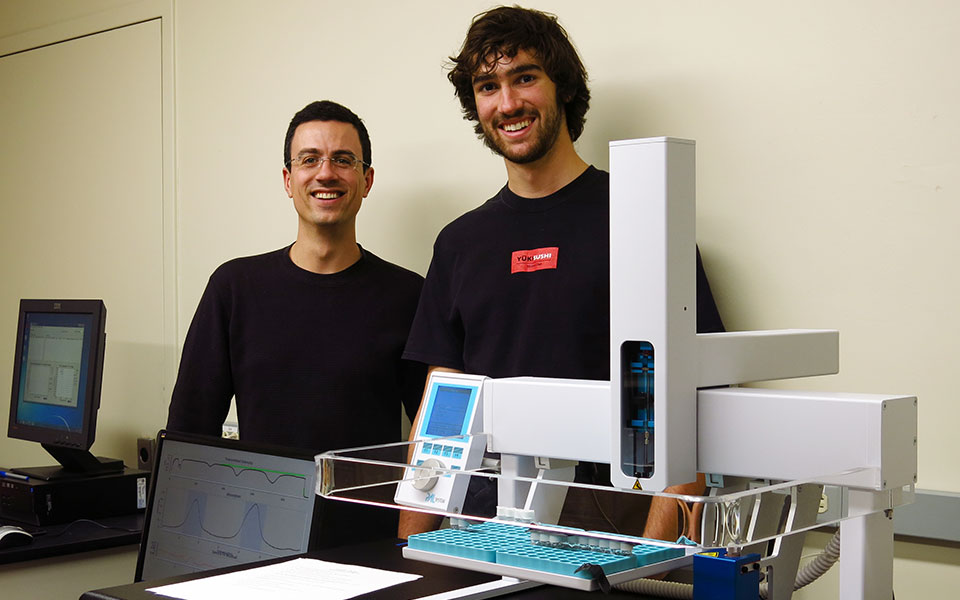
Molecules and Mountains
Alec Kwo ’16
Can the growth of an Alaskan mountain range affect the weather in California? Sean Reilly ’16 is finding out.
Have you ever thought about how the growth of an Alaskan mountain range could affect the weather here in California? Sean Reilly, class of ‘16, most certainly has. After receiving one of the the School for Field Studies (SFS) Distinguished Student Research Awards, in recognition of his environmental research while abroad in Australia, Sean is now focusing on conducting research on various water samples in the brand new Stable Isotope Laboratory in Daly Science, with Environmental Studies & Sciences (ESS)Assistant Professor Hari Mix. The pair has been using a new laser absorption spectroscopy machine to make rapid and extremely accurate measurements on various water samples; the technology has a wide variety of climate science and hydrological applications. Sean and Hari are specifically interested in looking at the presence of the Oxygen isotopes in water samples from the Northern Sierras and the Alaskan Range in regards to weather patterns, temperature change over time, and mountain range growth.
The project that Sean is about to take on is an appropriate blend of the passions and interests that he has developed throughout his life. Sean has lived most of his life in San Jose, but he fondly remembers frequent trips and time spent up in the Santa Cruz mountains with his family. Having taken his very first steps in the Santa Cruz Mountains, Sean developed an affinity for the outdoors at a young age that has progressively grown throughout his life. He also recounts going to Marine Biology summer camps growing up that sparked his interest in environmental issues. During high school, Sean joined the environmental justice club and began rock climbing (currently his favorite outdoor activity). Sean notes that the more he has learned about environmental issues, the more responsibility he feels to do his part for this cause: “I remember the first time I went to an old-growth forest and feeling very small. I wondered how anyone could come into a place so beautiful and with so much history and want to tear it down for profit.” Fast-forwarding to the present, Sean is now an environmental science and biology double major, President of SCU’s GREEN (Grass Roots Environmental Efforts Now) Club, and President of SCU’s Rock Climbing Club.
This spring break, Sean and Hari will be traveling to the Northern Sierras to collect and analyze water samples directly from the mountains that may clarify how old the Northern Sierras are (substantial debates exist as to how old the mountain range is). By observing the rainfall patterns that travel through and around the Northern Sierras over time, they may be able to settle this long disputed topic. Though the analyses of the water samples takes place in a confined laboratory, the location of the research site is ideal for Sean and his passion for experiencing the outdoors.
The adventures do not end after spring break. This upcoming summer Sean and Hari will be conducting similar experiments in the Alaskan Range for an entire month. The rainfall that passes through the Alaskan Range eventually reaches California, which makes the mountain range more relevant to us Californians than we may initially posit. Measuring the Oxygen isotope ratios will allow them to observe if rainfall patterns have changed trajectory over time due to factors such as glacier growth, growth of the Alaskan Range itself, or temperature changes where the range is located. By the end of their time in the mountains, Sean and Hari hope their findings will allow us to more accurately predict California weather patterns.
After taking the new absorption technology to near and distant mountain ranges, Sean hopes to continue his research in the Stable Isotope Laboratory by investigating statewide water conservation issues. Sean wants to take samples from inlets and outlets of reservoirs and aquifers that California cities (i.e. Los Angeles) extract water from. The difference in isotope ratios at the inlets of reservoirs to the isotope ratios at the outlets will indicate how much water is lost simply to evaporation. In turn, water suppliers will be able to look into more efficient ways of transporting or storing water.
Though the water samples are mere microliters in volume, they have grand applications. Stable Isotope research is quite young, which gives Sean a bright outlook on what the technology can continue to contribute to the world.
More on the machine:
The absorption machine is quite remarkable. Water samples are vaporized in an injection block and funneled into a separate chamber. Inside the chamber there are two, slightly offset lasers that pass through the vapor and eventually hit a detector. This detector indicates the relative ratios of O16, O17, O18, Hydrogen, and Deuterium from the lasers’ measurements.
Alec Kwo ‘16 is a sustainability intern for Student Engagement at Santa Clara University.